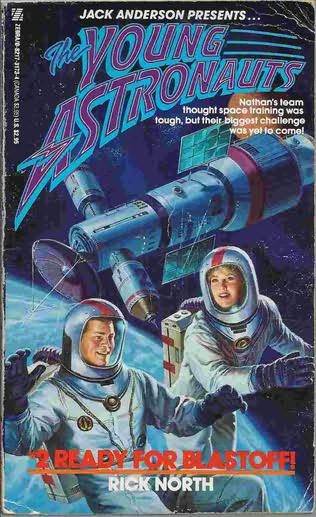Into the Wardrobe: READY FOR BLASTOFF! (1990) by Rick North

Ready for Blastoff! is the second entry in “The Young Astronauts” series, a collection of six middle-grade books published in 1990–1991 and “presented by Jack Anderson,” a nationally syndicated newspaper columnist and investigative reporter who passed away in 2005. The series is linked to the Young Astronaut Council, Inc., which still exists, providing school enrichment through a “STEM-based space-themed, pre-afterschool television show.” The origin of the Young Astronaut program lies in an oval office meeting between Anderson and then President Reagan in 1984. Anderson noted: “I’ve noticed two things about my grandchildren. They love space. They were excited about space. They hated school.” With a view on declining US student math and science scores, Reagan quickly adapted the idea into a political reality that developed into an international program of conferences, school chapter activities, and this series of stories published by Zebra books. I only found this second volume in the thrift shop, so I haven’t read the first book, but that didn’t really create any difficulty with getting into this one. It begins with a prologue where a UN/NASA international team of seven sixteen-year-old astronauts blasts off from Earth: destination Mars. The prologue introduces each of the team members, their personalities, and the struggles that they have gotten through to reach this momentous occasion. The team consists of Nathan Long (team leader), Karl Muller, Sergei Chuvakin, Alice Thorne, Noemi Velazquez, Genshiro Akamasu, and Lanie Rizzo, who harbors a secret. The prologue also sets up one of the novel’s antagonists, Suki, the leader of another team that will soon follow Long’s team to Mars. The twenty-one short chapters of the novel then flashback in time to show the challenges the team successfully faces leading up to their departure from Earth. These include both physical and mental obstacles, from nausea in zero-G simulations to imposter syndrome. As the characters rise to meet these challenges and trust one another to come together, the story demonstrates to readers qualities of perseverance and teamwork. The diversity of the characters is both a strength and weakness in terms of how well issues are handled, particularly from a present-day perspective. One thing covered well is the issue of socioeconomic privilege, though it’s not of course directly called that in a book from the 1990s. What the novel does less well from a perspective of today is the racial, ethnic, or gender diversity, which definitely comes across as being presented in typical fashion for the era: the diversity is there, but it’s still rather stereotypical and limited. For instance, the Japanese teen loves Godzilla, and the affluent girl loves fashion and shopping. While Nathan Long exists as a typical clean-cut, male leader, he demonstrates support and care, without domineering, bias, or aggressiveness. The name “Rick North” is a house pseudonym used for the Young Astronaut series, and this particular novel is written by John Peel, a prolific author of SF media tie-in franchise novels (from Star Trek to Dr. Who) who might be familiar to many readers out there. In all, Peel does a great job with Ready for Blastoff!, balancing plot and character development well within the book’s short length. He also includes several situations that show the characters using their minds and compassion to overcome mishaps or dangers. Aside from the competitive antagonism the team receives from Suki, most of the story deals with the team members having to deal with training while under the scrutiny of a hostile media writer and her photographer/cameraman. From this one volume of the series, at least, I’m reminded of Mary Robinette Kowal’s recent “Lady Astronaut” series. The two series share a lot in common in terms of themes, albeit Kowal’s for a more adult audience (while still readable by YA). I imagine that the “Young Astronaut” series would have been effective for getting young readers at the time more interested in STEM and space, at least those with nerd proclivities. I’m not sure it would have the same effect on middle grade readers today, though I could see this series being modernized and brought back, for instance through the involvement of an Abigail Harrison (Astronaut Abby) type STEM communication personality.
Adventures in SF Parenting: From Stern to STEM

One big benefit of opening a toy store is that when my kids arrive there after school, we are all stuck in the same space together and for the first time in YEARS, I get to help them with their homework! “Years?! What a horrible mother! You should have been supervising them THIS WHOLE TIME!” Yah, yah. Bite me. My kids have been better at their schoolwork than I am since 3rd grade. I gave up a while ago. However, they just started Algebra when they hit 7th grade, so we all get to puzzle it out together. This is both nice and frakking awful. Though I have internalized the mantra, “All are capable of math. There is no such thing as a ‘a math person,’ there are only those who give it a chance and those who do not,” I still struggle with some of the simpler concepts. However, now that I’m older, I do find that I can *enjoy* the struggle. Somehow, probably completely by accident, both of my daughters also seem to enjoy math and both recognize that it can be useful in their chosen “hobbies”. MoMo (#1) is an artist. She works on paper, but is already better at digital production and reproduction of artwork than I will ever be. I have the benefit of a (slim) digital media background and have been able to give her the tools and basic education she needs to learn how to create digital masterpieces. It is a joy to watch her grow in her love of the medium. Whether she was inspired by comic books, video games, cartoons, or what, I have no idea. However, she obsessively watches YouTube videos of people drawing random things (seriously, HOURS) and is exploring the realms of Manga and Anime. Granted, we raised her up right by forcing her to watch Studio Ghibli films on an endless loop – Clockwork Orange style. Messy Jessy #2 is a scientist/engineer/punky brewster. Her favorite toys from about age 3+ were Magnetix. Basically, if it let her build something, she could spend hours building random shit. From simple octagons, to massive buildings with parapets and flying buttresses. Her passion is construction, so every time we found a science kit that allowed her to explore this avenue, we did so. The cavern under her bed is a treasure trove of robotics. She is the proud owner of a soldering gun and a java programming manual (seriously, would someone *please* write a java programming instructional book for kids? I’m disturbed by the lack of them). Anyway, this past summer we were lucky enough to be able to encourage our daughters passions even further. Parents should be the first line of inspiration into math and science careers, with public schools following closely on their heels. However, it is exceedingly important that the surrounding community also offer programs that support these career paths. This not only benefits a child’s education, but it also benefits the county and city coffers. Tech businesses don’t stay in California’s Silicon Valley due to the cheap rent, they stay due to the sustainable brain capital. It’s practically splitting at the seams with generation after generation of IT workers – the 60+ year olds who founded the industries, the 40+s who turned them into powerhouses, the 20+s who spawned a new generation of web-based technologies, and the 5+s who are sitting at home on their parents I-pads, exploring technology in ways that my generation only saw in Science Fiction TV. The communities that want to capitalize on the new creative economy of the US are the ones that will institute programs that create these budding technologists. My daughters were participating in one such program. It was a partnership between a local youth based educational initiative and a Community College in the town where my parents live. For the cost of a Youth Recreational Summer Camp, they attended what were, essentially, college classes for a week. The one week program included more classes than I can even remember and gave children the freedom to explore numerous future careers and hobbies. MoMo took a class on digital art, which included instruction in Corel Painter and Adobe Photoshop. She learned how to interact with a drawing tablet, manipulate existing images, and create original artwork. Though the teacher left something to be desired in the personality department, the class gave her the information she needed to take her art to the next level. She now wants to figure out how to animate her work and I suspect she’ll begin designing Flash games sooner rather than later. Messy Jessy spent a week learning about different types of Engineering. With WOMEN! This was such a crucial experience for her, as it is for most young girls. Women still only account for a minimum proportion of STEM jobs, though the number of women receiving degrees in STEM fields has increased. It is difficult to say what societal pressure causes girls to not pursue math and science, but the pressure is there and so a great effort must be made to overcome it. Jess’s “Women in Engineering” course introduced the all-female class to a new field of Engineering every day of the week, hosted by a woman in each specific subset. They did projects in fields that ranged from Bio-Medical Engineering to Environmental Engineering, Electrical and Aeronautic. They touched a human heart while exploring artificial heart valves and MacGuyvered a set of Earphones. Basically, it was just frakking amazing. Will either of my daughters choose a career that is related to the respective courses they took this summer? I have no idea. Nor do I care. As a parent, I must encourage them to follow their passions, but when they are no longer passions, I must allow them to choose another. Honestly, if there is only one thing that I learned from Science Fiction and Fantasy, it’s that choosing your own path in life is the key to happiness. However, for now, I’ll keep

